From Kristen Smith:
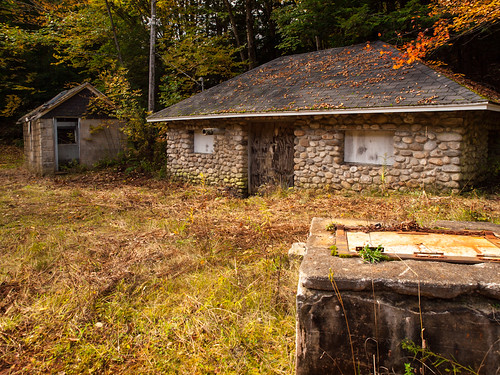
(An old camp or lodge in New Hampshire)
We recently received some new information about the old Curtis Paper Mill smokestack in Newark, Delaware, that Mick Melvin posted about in the fall of 2010 (see September 12, 2010, "Smokestack Lightnin'").
Backside fan David Huntley tells us that the stack, which since 2007 has been the sole remnant of the factory that stood there since the Industrial Revolution, is slated for demolition.
"There is a pre-demolition meeting scheduled in a couple of weeks to discuss HAZMAT removal and disposal," David said in an email. "I expect demolition to occur within the month if there are no weather or other impediments."
David was kind enough to send us a few close-up shots, in which you can see the stack's comprised condition.
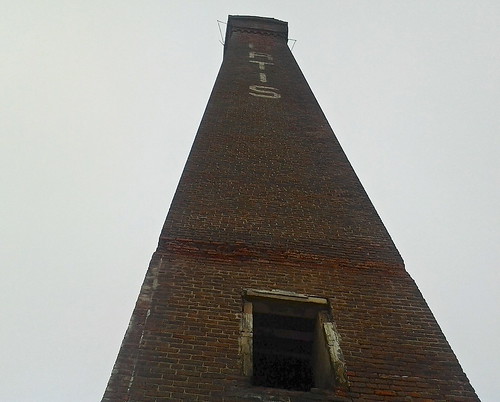
(Curtis Paper Mill smokestack, Newark, Delaware)
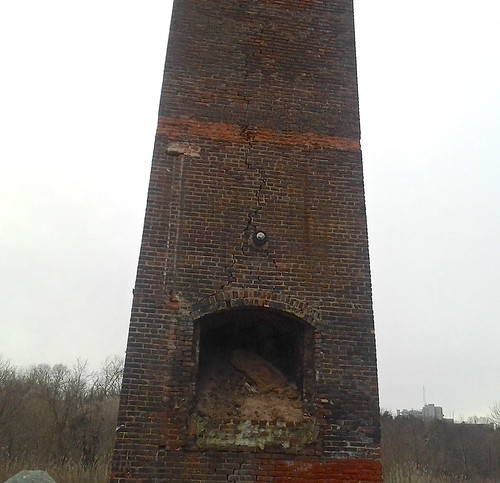
(Curtis Paper Mill smokestack, Newark, Delaware)
From Pete Zarria:
Route 66 still maintains quite a bit of its roadside charm on the Backside of America. It has to be searched out, but with minimal effort.
The reward is a trip back in time to an America of far more freedom. The roads followed their own course instead of being plowed through with dynamite. Every attraction and amenity was provided by an entrepreneur, their places made unique by locations and personalities.
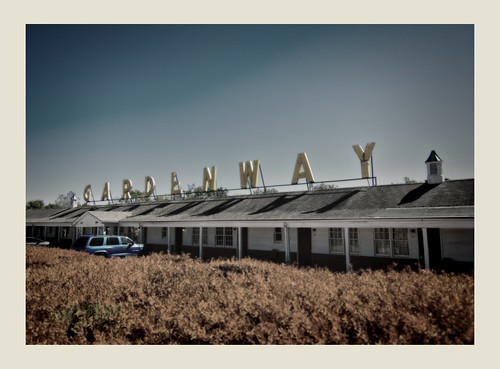
(Gray Summit, Missouri)
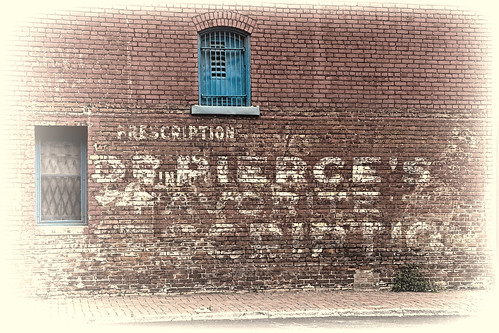
(Webb City, Missouri -- Dr. Ray Vaughn Pierce was a patent medicine huckster with a laboratory in Buffalo, NY. He produced millions of dollars worth of patent remedies. As well as the Pleasant Pellets, there were Dr. Pierce’s Anuric Tablets, Dr. Pierce’s Favorite Prescription, Dr. Pierce’s Vaginal Tablets, Dr. Pierce’s Extract of Smart-Weed and Dr. Pierce’s Golden Medical Discovery – a licorice-flavoured tonic that reportedly contained quinine, opium and alcohol and was advertised as giving men “an appetite like a cow-boy’s and the digestion of an ostrich.” Dr. Pierce's products were available into the 1970s.)
It's a pity we now suffer the depressing view of sameness to everything we encounter on any drive. There is nothing like the individuality of a bright neon sign in the night.

(Mitchell, Illinois)
From Dave Brigham:
For the last year and a half, I've been on the trail of a mystery from my childhood. When I was 14 or 15, two kids who were a year or two older told my friend Pat and me about an abandoned house down by the railroad tracks not far from our neighborhood.
We walked on the tracks regularly to get to a small grocery store and candy store. We also played around down by a couple of nearby ponds, and every once in a while crawled through a tunnel that went under the tracks. So we knew the area pretty well.
We checked out the house, and it was indeed abandoned, but it was filled with somebody's stuff. Whoever had lived there had either gotten out in a hurry, or died and didn't have anybody to take care of going through the stuff.
That mystery has followed me throughout my life. I harken back to it with some frequency, and even put a similar event in a short story I wrote years ago.
In mid-2011 I posted to a Facebook group dedicated to people who grew up in my hometown of Simsbury, Connecticut, wondering if anybody knew about the house, and who lived there. I learned that the guy who lived in the house was named President Little, which is an awesome name. Some folks who grew up near me, and who were a few years ahead of me in school, said that as teenagers they'd hung out with Mr. Little, something their parents wouldn't have liked if they'd known about it.
President had told them he was the son of slaves and that he had no family, so these folks on Facebook figured that's why his house was full of stuff when he died. The house was torn down in the early '80s to make way for an apartment complex.
But having learned the name of the guy who lived there, I grew curious about the patch of woods just to the south of the apartment complex entrance.
In August 2011, I was back in my hometown for a golf tournament, and took a chance to visit the site where his house once stood, and was amazed that there were remnants of President Little's stuff left behind. I took a bunch of pictures, and when I got back home I started doing research online (see September 20, 2011, "In Search of President Little").
I learned that President's parents were born in the 1880's, so they weren't slaves. But it's quite possible, likely even, that he was the grandson of slaves.
I also learned that he had several children, most of whom were alive when he died. So why had none of them cleared out his house when he died?
Through a web site operated by the fiance of the late President Little's granddaughter, I discovered that at least one of his children, a son named Hood, was still alive.
I emailed the guy who ran the web site -- which detailed the Little family's genealogy -- and he gave me Hood's phone number in Florida. I asked him if he thought it would be OK for me to call him to ask him a few questions about my childhood mystery. He said sure.
I debated whether to call. How would I explain what I wanted, when I wasn't really sure? Would Hood Little think I was crazy? Would he blow me off?
After hemming and hawing for a week or so, I finally called. I was happy to hear his voice after a few rings. I fumbled through a quick explanation of who I was and what I wanted to talk to him about, as I wasn't sure whether he'd been told that I might call.
He seemed willing to talk to me, but told me he was on another call on his cell phone, and that I should try him back shortly. I waited about 10 minutes and called, but nobody picked up. There was no answering machine. Nothing, just ringing.
I tried again one more time a few days later and again got no answer. I decided that I shouldn't bother this guy, and my passion for pursuing the mystery of President Little subsided. Oddly enough, a few weeks after my second attempt to reach him, Hood Little called me. But I think it was a mistake, as when I answered the phone, he wasn't there and then he hung up.
In the meantime, I exchanged emails with a woman from the Simsbury Historical Society. She sent me a few interesting tidbits about President Little, which she discovered in newspaper archives. His son was hit by a car and killed at age 16 in 1941. Two years prior to that tragedy, President Little and another man were arrested by State Police for running a still and possession of firearms, "from which the numbers had been filed."
Obviously, my curiosity was stoked.
But no more information was forthcoming.
Until last week, I'd put the conundrum onto one of my mental back burners. Out of the blue, I received an email from a woman who grew up with President Little's son, providing me with some tantalizing new information.
Somebody at the historical society had forwarded to this woman, whose name is Mary, an email I'd sent them looking for information about President Little. Mary spends her winters in Florida, but is a member of the historical society. She and some friends are working on a history of the Weatogue section of Simsbury where I grew up.
She was in the same high school class as President Little's son, who was a junior. She remembered him well, she said, because he was the only black kid in the class. She also remembers well the day he died in 1941, when he was hit by a car on a busy road in Avon, close to his home in Simsbury.
Mary was kind enough to ask some of her friends what they remembered about President Little Jr. and his family. This, as so happens with historical research, is where things get a bit complicated.
One person remembered the Little family living across the street and a bit further south from the house I knew about. Somebody else said they lived on the same side of the road, but even further south toward the Avon town line.
I'll need to make a visit or two to Simsbury town hall and dig into some records to solve this mystery, but that's not going to happen any time soon. I believe that the Littles lived in the house I remember, because there were few black families in town at that point, and there were photos in the house of black family members.
When this all started jumbling in my mind a year and a half ago, I wondered what I might do with this information. I thought about writing some sort of historical or genealogical article, or a short story or novel. I am leaning toward a short story now, having garnered quite a bit of interesting and intriguing information.
I have not given up on the idea of working with somebody at the historical society or another local organization to do some sort of archaeological dig at the site. There are bottles, cans, pots, old shoes and other items on the surface, but they are sinking further each minute. I assume that under this detritus there may be more interesting items.
I find it appalling that when the apartment complex developer knocked down the house, they didn't do a better job of clearing out the previous owner's small stuff.
Here are a few more photos I took during my visit there in August 2011.
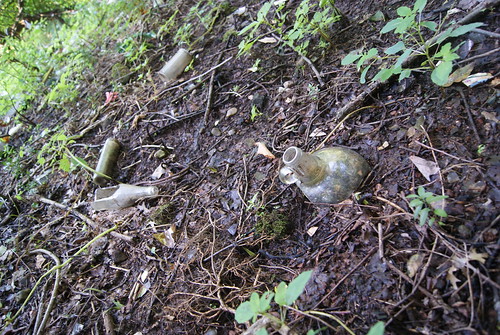
(Old bottles at the site where President Little's house once stood)

(Old can at the site where President Little's house once stood)

(Old shoe at the site where President Little's house once stood)
From Dave Brigham: Benvenuti all'ultimo post su Worcester! For this latest installment of my ongoing series about Woostah, Mass., I ...
